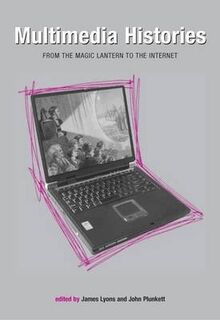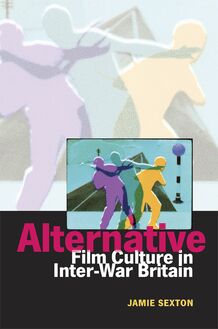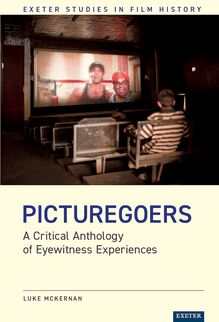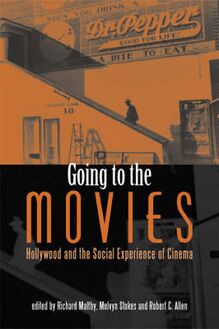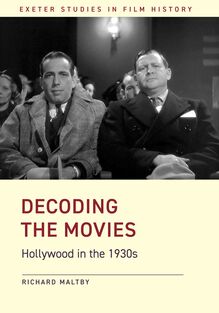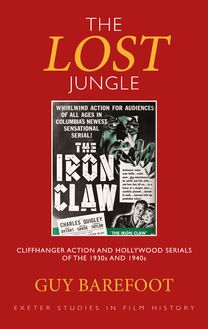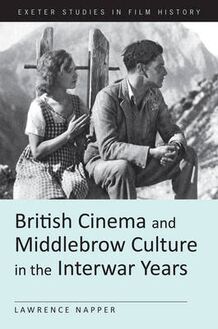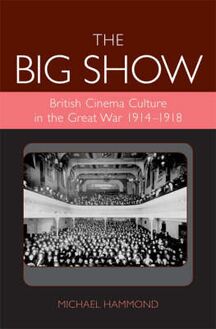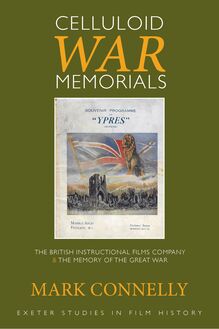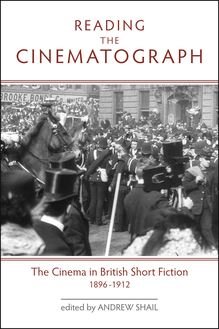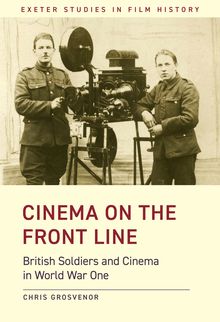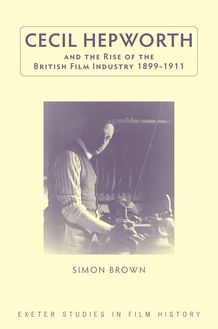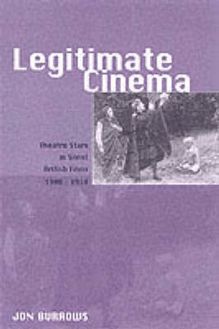-
 Univers
Univers
-
 Ebooks
Ebooks
-
 Livres audio
Livres audio
-
 Presse
Presse
-
 Podcasts
Podcasts
-
 BD
BD
-
 Documents
Documents
-
- Cours
- Révisions
- Ressources pédagogiques
- Sciences de l’éducation
- Manuels scolaires
- Langues
- Travaux de classe
- Annales de BEP
- Etudes supérieures
- Maternelle et primaire
- Fiches de lecture
- Orientation scolaire
- Méthodologie
- Corrigés de devoir
- Annales d’examens et concours
- Annales du bac
- Annales du brevet
- Rapports de stage
La lecture à portée de main
Vous pourrez modifier la taille du texte de cet ouvrage
Découvre YouScribe en t'inscrivant gratuitement
Je m'inscrisCecil Hepworth and the Rise of the British Film Industry 1899-1911 , livre ebook
Découvre YouScribe en t'inscrivant gratuitement
Je m'inscrisEn savoir plus
Vous pourrez modifier la taille du texte de cet ouvrage
En savoir plus

Description
This book offers an industrial, economic and aesthetic history of the early years of the British film industry from 1899–1911, through a case study of one of the most celebrated pioneer film makers, Cecil Hepworth.
Presenting a picture of daily life in his film studio, an analysis of Hepworth’s films is offered including the development of their content, production methods and marketing in this formative period.
The early twentieth century saw British film production develop from a cottage industry of artisans to a multi-modal complex economic system with a global reach. Changes in the nature of exhibition and distribution caused a major crisis in the years 1908–1911, whereby Britain lost its status as a world leader in film making. Existing histories of this period lay this crisis at the feet of pioneers like Hepworth, whose perceived inability to improve the quality of film production led to stagnation.
Brown attempts to challenge this assumption by analysing Hepworth’s development of production methods as well as his strategies towards sales in the market to demonstrate the impact on the modernisation of the film industry.
Introduction
List of Illustrations and Tables
Film Production and the Hepworth Manufacturing Company Ltd (HMC)
Hepworth, Film Sales and the Rise of the Renter
The HMC, the Rental Sector and Market Strategies
HMC and Patterns of Exhibition
Conclusion: The Producers’ Response to the Crisis
Appendix One: Filmography of Hepworth and Co and the HMC 1899–1911
Appendix Two: HMC Titles Listed in ‘Around the Shows’ Released 1 October 1908–31 August 1909
Appendix Three: List of London Based Rental Firms (1905–1911) and Foreign Film Sales Representatives (1907–1911)
Bibliography
Index
Sujets
Social History
Industries
HISTORY
Reino Unido
Película fotográfica
General officer
Ireland
20th century
United Kingdom
History of Europe
Cinema of the United Kingdom
History of film
Entertainment
Economics
Stephen Ireland
Great Britain
Business
General
Cecil Hepworth
Film
Industrie
Royaume-Uni
Media
Europe
Informations
| Publié par | University of Exeter Press |
| Date de parution | 31 juillet 2019 |
| Nombre de lectures | 1 |
| EAN13 | 9780859899918 |
| Langue | English |
| Poids de l'ouvrage | 1 Mo |
Informations légales : prix de location à la page 0,5625€. Cette information est donnée uniquement à titre indicatif conformément à la législation en vigueur.
Extrait
Cecil Hepworth and the Rise of the British Film Industry 1899-1911
An industrial history of the formative years of the British film industry from 1899 to 1911, through a case study of Cecil Hepworth – one of the most celebrated pioneer British film makers. It offers a detailed picture of the workings of an early British film studio, charting alongside that the development of the British film industry itself.
1899 to 1911 saw the British film industry change from a cottage industry of artisans and inventors into a complex economic system of interrelated businesses with a global reach. Changes in exhibition and distribution caused production to suffer a major decline from 1908 to 1911, losing Britain its status as a world leader in film making, a position it has struggled to regain ever since.
This book challenges such assumptions by offering a detailed analysis of Hepworth’s developing production methods and his strategies towards sales in the market together with an examination of the changing nature of the market itself. It demonstrates how these changes impacted on Hepworth’s attempts to modernize, and in doing so offers a more accurate picture of this period in British film history.
Simon Brown ’s book is an industrial history of the early years of the British film industry from 1899–1911 presented through a case study of one of the most celebrated pioneer film makers, Cecil Hepworth. It provides a picture of the changing nature of daily life in Hepworth’s film studio, alongside which it charts the development of the British film industry, in particular the development of exhibition and distribution.
Simon Brown is Director of Studies for Film and Television at Kingston University, London.
Exeter Studies in Film History
Published by University of Exeter Press in association with the Bill Douglas Centre
for the History of Cinema and Popular Culture
Series Editors: Richard Maltby, Professor of Screen Studies, Flinders University, South Australia and Steve Neale, Professor of Film Studies and Academic Director of the Bill Douglas Centre, University of Exeter.
Parallel Tracks: The Railroad and Silent Cinema , Lynne Kirby (1997)
The World According to Hollywood, 1918–1939 , Ruth Vasey (1997)
‘Film Europe’ and ‘Film America’: Cinema, Commerce and Cultural Exchange 1920–1939 , edited by Andrew Higson and Richard Maltby (1999)
A Paul Rotha Reader , edited by Duncan Petrie and Robert Kruger (1999)
A Chorus of Raspberries: British Film Comedy 1929–1939 , David Sutton (2000)
The Great Art of Light and Shadow: Archaeology of the Cinema , Laurent Mannoni, translated by Richard Crangle (2000)
Popular Filmgoing in 1930s Britain: A Choice of Pleasures , John Sedgwick (2000)
Alternative Empires: European Modernist Cinemas and Cultures of Imperialism , Martin Stollery (2000)
Hollywood, Westerns and the 1930s: The Lost Trail , Peter Stanfield (2001)
Young and Innocent? The Cinema in Britain 1896–1930 , edited by Andrew Higson (2002)
Legitimate Cinema: Theatre Stars in Silent British Films 1908–1918 , Jon Burrows (2003)
The Big Show: British Cinema Culture in the Great War (1914–1918) , Michael Hammond (2006)
Multimedia Histories: From the Magic Lantern to the Internet , edited by James Lyons and John Plunkett (2007)
Going to the Movies: Hollywood and the Social Experience of Cinema , edited by Richard Maltby, Melvyn Stokes and Robert C. Allen (2007)
Alternative Film Culture in Inter-War Britain , Jamie Sexton (2008)
Marketing Modernity: Victorian Popular Shows and Early Cinema , Joe Kember (2009)
British Cinema and Middlebrow Culture in the Interwar Years , Lawrence Napper (2009)
Reading the Cinematograph: The Cinema in British Short Fiction 1896–1912 , edited by Andrew Shail (2010)
Charles Urban: Pioneering the Non-fiction Film in Britain and America, 1897–1925 , Luke McKernan (2013)
UEP also publishes the celebrated five-volume series looking at the early years of English cinema, The Beginnings of the Cinema in England , by John Barnes.
First published in 2015 by University of Exeter Press Reed Hall, Streatham Drive Exeter EX4 4QR UK www.exeterpress.co.uk
© Simon Brown 2015
The right of Simon Brown to be identified as author of this work has been asserted by him in accordance with the Copyright, Designs and Patents Act 1988.
Although every effort has been made to identify owners of copyright material, in some case this has not been possible. Notification of omissions or incorrect information should be forwarded to the publishers, who will be pleased to amend any future editions of the book.
All rights reserved.
British Library Cataloguing in Publication Data A catalogue record for this book is available from the British Library.
ISBN 978 0 85989 8904 Hardback
ISBN 978 0 85989 9918 epub
ISBN 978 0 85989 9901 PDF
Typeset in Caslon by Kestrel Data, Exeter
Contents
List of Illustrations and Tables
Acknowledgements
Introduction
1 Film Production at the HMC
2 Hepworth, Film Sales and the Rise of the Renter
3 The HMC, the Rental Sector and Market Strategies
4 The HMC and Patterns of Exhibition
Conclusion: The Producers’ Response to the Crisis
Appendix One: Filmography of Hepworth and Co and the HMC, 1899–1911
Appendix Two: HMC Titles Listed in Around the Shows Released 1 October 1908–31 August 1909.
Appendix Three: List of London Based Rental Firms (1905–1911) and Foreign Film Sales Representatives (1907–1911)
Notes
Bibliography
Index
List of Illustrations
Cover image: Cecil Hepworth
1 Image of Walton on Thames High Street c .1910
2 Drawing of The Rosary by Cecil Hepworth c .1899
3 Drawing of the Hepworth Studio c .1905 by Cecil Hepworth
4 Drawing of the Hepworth Studio c .1908 by Cecil Hepworth
5 / 6 Image of the Index for Hepworth’s 1906 catalogue
7 Advertisement from the KLW 19 September 1908, p. 324, highlighting Hepworth’s signature films
8 Around the Shows Column from the Bioscope 27 May 1909 showing The Cat Came Back listed as being screened at the Central Hall, Oldham
9 Envelope containing promotional stills of Hepworth’s Stock Company c .1912
List of Tables
1 Number of HMC Films Released Year on Year 1904–1911
2 Average Length (in feet) of HMC Films Released Year on Year 1904–1911
3 Growth in the Number of Rental Firms in London Year on Year 1905–1911
4 Number of Sales Agents and Representatives of Foreign Production Companies in London Year on Year 1907–1911
5 Number of HMC Films Listed in Around the Shows Plotted Against the Number of Screenings
6 Non-Fiction Titles Released by HMC between 1 October 1908 and 31 August 1909 and Listed in Around the Shows
7 HMC Films Released in March 1909 and Listed in Around the Shows
Acknowledgments
This book is the result of thirteen years of research and would not have been possible without the help and support of a number of people and institutions. My first thanks must go to the late Val Williamson, Cecil Hepworth’s daughter, who was exceptionally generous in sharing her memories of her father and her thoughts about both his career and my work. She was very proud of her dad and it is a great sorrow that she did not live to read this work, although I sincerely hope, and in my lighter moments allow myself to believe, that she would have approved of it. My second thanks must go to Simon Baker at the University of Exeter Press, not only for taking a chance on this book, but for flying the flag for the publication of works on early British cinema. It’s not the sexiest of subjects to be sure, but there is much excellent and important work being done in this field, and the commitment of Exeter Press to publishing work in this area is invaluable.
The book began life as a PhD thesis at Birkbeck College, and I am indebted to Ian Christie for his support in marshalling my ideas into a coherent argument, and to Lee Grieveson and Simon Popple who offered such helpful advice. They are just some of the many scholars who have both inspired and supported me over the years, and in particular I wish to thank Luke McKernan and Andrew Shail, both outstanding early cinema historians, for their help and comments and, outside of the early cinema world, Matthew Pateman for his unfailing and inspiring belief in my abilities.
I’d also like to thank my colleagues in the Department of Film, TV and Media at Kingston University for graciously supporting my sabbatical so I could finish the writing, and of course the staff of the BFI Reuben Library for their unfailing good humour, assistance and guidance, especially Shaun, Emma and Anastasia. Also Janet Moat of BFI Special Collections who let me trawl through the many boxes of the Denis Gifford Collection, Phil Wickham of the Bill Douglas Centre in Exeter, and the curators of the Elmbridge Museum who do such good work in keeping the memory of Hepworth alive. I would also like to thank Sue Webber of Elmbridge Museum, Phil Wickham, Sarah Wilde and Emma Smart of the BFI, and my colleage at Kingston Fleeta Chew Siegel, for their generous halep and support with the illustrations.
Ultimately any kind of major endeavour like this requires the support of friends and, especially, family. I’m indebted to all of my friends who have listened patiently to my Hepworth stories over the years, especially Sergio Angelini, Sheldon Hall, Anne Jenkins, Miles Booy, Wendy Roper, Deborah Mo, Alice Black and Karen Myers. I’d also like to thank my mother Sheila and my dear late father George for their love, and for instilling in me the joy of learning and the value and rewards of plain old-fashioned hard work.
Most importantly, I share this book with my own family; my wife Stacey, and my two dogs, Max and Lily. Much of the ideas in this book have been formulated and fermented on my twice-daily walks with the dogs, while much of the writing has been done with them curled up beside me on the sofa or at my feet. I’m grateful to them for every moment they waited pat
-
 Univers
Univers
-
 Ebooks
Ebooks
-
 Livres audio
Livres audio
-
 Presse
Presse
-
 Podcasts
Podcasts
-
 BD
BD
-
 Documents
Documents
-
Jeunesse
-
Littérature
-
Ressources professionnelles
-
Santé et bien-être
-
Savoirs
-
Education
-
Loisirs et hobbies
-
Art, musique et cinéma
-
Actualité et débat de société
-
Jeunesse
-
Littérature
-
Ressources professionnelles
-
Santé et bien-être
-
Savoirs
-
Education
-
Loisirs et hobbies
-
Art, musique et cinéma
-
Actualité et débat de société
-
Actualités
-
Lifestyle
-
Presse jeunesse
-
Presse professionnelle
-
Pratique
-
Presse sportive
-
Presse internationale
-
Culture & Médias
-
Action et Aventures
-
Science-fiction et Fantasy
-
Société
-
Jeunesse
-
Littérature
-
Ressources professionnelles
-
Santé et bien-être
-
Savoirs
-
Education
-
Loisirs et hobbies
-
Art, musique et cinéma
-
Actualité et débat de société
- Cours
- Révisions
- Ressources pédagogiques
- Sciences de l’éducation
- Manuels scolaires
- Langues
- Travaux de classe
- Annales de BEP
- Etudes supérieures
- Maternelle et primaire
- Fiches de lecture
- Orientation scolaire
- Méthodologie
- Corrigés de devoir
- Annales d’examens et concours
- Annales du bac
- Annales du brevet
- Rapports de stage
